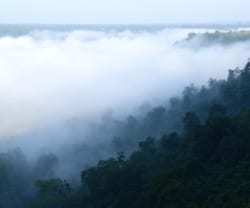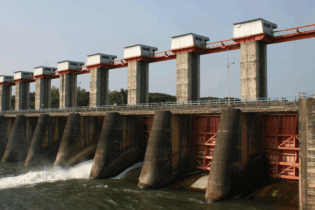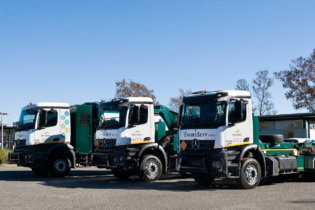South Africa is facing a major water crisis. The impact of water shortages is felt most acutely in rural areas where there are no major surface- or groundwater resources and where it is not economically viable to install a water reticulation network. It is imperative that such communities be supplied with water. One of the more unconventional sources of water is fog.
During the Water Research and Development Technology Symposium which took place recently researchers from the University of Pretoria showcased two of the Water Research Commission (WRC) – funded innovations on fog harvesting. The first innovation is a measuring instrument for low and intermittent water flow. The volume of fog varies considerable from hundreds of litres per day to less than one. Water collection is also intermittent with a lot of water collected during wet conditions to none during sunny periods. Conventional water flow meters invariably fail during these conditions. Prof Johan van Heerden, a leading researcher based at the University of Pretoria has built a low flow meter (LFM) that can measure such flows. It is based on a tipping bucket principle but can measure 1 to 1.5 litres per tip. The LFM is made from perspex to enable easy identification of blockages. The system has been tested for the last 2 years – under field conditions – and is robust and accurate. The second innovation is an apparatus that can be used to harvest fog water during near-windless conditions (the Whirly). The previous systems – and those used world-wide – are static nets that rely on fog bearing winds to blow through the system, depositing tiny fog droplets of water on the screen. These droplets then coalesce, become heavier and trickle downwards. They drip into a gutter attached to the bottom of the screen. From there it is channelled to storage tanks. The new ‘invention’ consists of a vertical shaft with three nets attached. An electronic system has been attached that cause a rotor to turn – thereby rotating the nets when the relative humidity reaches 98% (as it does during foggy conditions). The system switches off when the fog ceases. The batteries that drive the system are charged by means of solar power. This system allows the capture of water during near windless conditions – a situation that often occurs on the West Coast. Both innovations are products of the WRC fog water harvesting project. A scale model of the whirly as well as a fully functional low flow meter will be exhibited at the WRC innovation symposium on 26 September 2013. How does fog water harvesting work?Fog occurs frequently along the West Coast of South Africa as well as in the mountains forming the southern and eastern Escarpment. The WRC has funded research projects to determine the feasibility of fog water harvesting and to optimise the structure and design of fog water harvesting systems.
Each system comprised of a water collection screen and one or more storage tanks. The screen consists of three 6 m wooden poles mounted 9 m apart. Steel cables stretched horizontally between the poles and anchored the structure. Two sections of 9 m by 4 m shade cloth netting (40%) were draped over the top cable and secured to the middle and lower cables and to the poles on either side. This formed a fog collection screen of around 70 m2. A gutter was attached to the lower ends of the screen. During foggy and wet conditions, droplets are blown against the screen and are deposited on it. As the drops become larger, they trickle downwards and drip into the gutter. From there the water was channelled through a sand filter to a pipe that lead to10 000 ℓ tanks located down slope. When the top tank is full, the overflow is channelled to the next tank further down the hill, and so on. These fog harvesting technologies have been piloted in the West Coast at a small mission station called Lepelfontein in the Northern Cape, and the other at the Tshanowa Primary School in the Soutpansberg in Limpopo. There are no naturally occurring water sources at Lepelfontein or at Tshanowa. Water was previously trucked to Lepelfontein from the nearest town located about 70 km away, while at Tshanowa. Women and children had to collect water on a daily basis from a dam located 5 km from the school. The terrain is exceptionally steep and rugged in this area. The amount of water available to each family was thus limited to the amount of water that could be carried per trip. The design of the collector was based on that used in Chile, with significant modifications being made for South African conditions. The structures were specifically designed to be used in rural areas, to be as cost effective as possible, to use material that is readily available in the area, and to be suitable for use in areas without electricity. “The systems at Lepelfontein and Tshanowa were our first disigns that were based on the Chile model. We have further developed new modifications and innovations. One modification is that instead of having one flat vertical panel, we now put three panels (30 m2 each) in the form of a triangle. This provides stability to the system during storms. The other new innovations at the Whirly and the Low flow meter” explains Prof Jana Olivier, WRC project leader from the University of Pretoria. Approximately the same results were obtained for both sites. The mean daily water yields were approximately 4 l/m2/day, with maximum yields exceeding 3800 l/day. Although these yields were not very high, they did provide clean water to people who previously did not have easy access to any water. Unfortunately, a number of problems were experienced as a result of severe storms and lack of maintenance and vandalism. This necessitated modifications to the design so as to optimise water harvesting.







